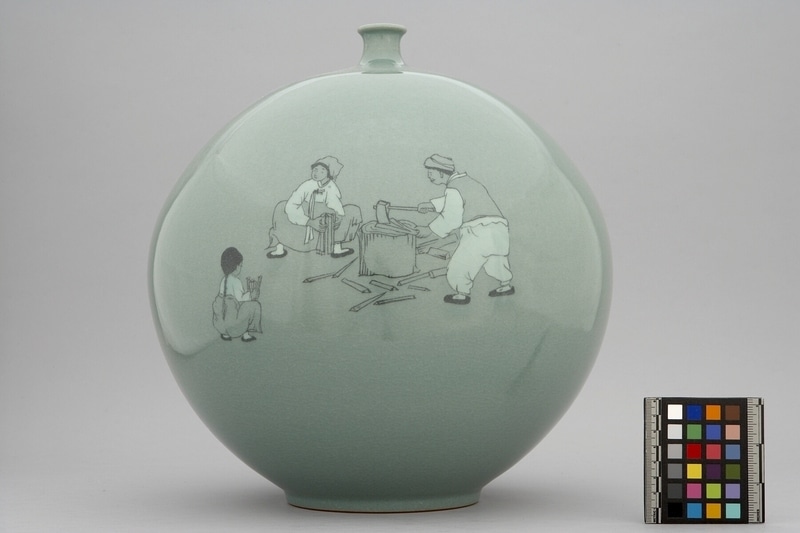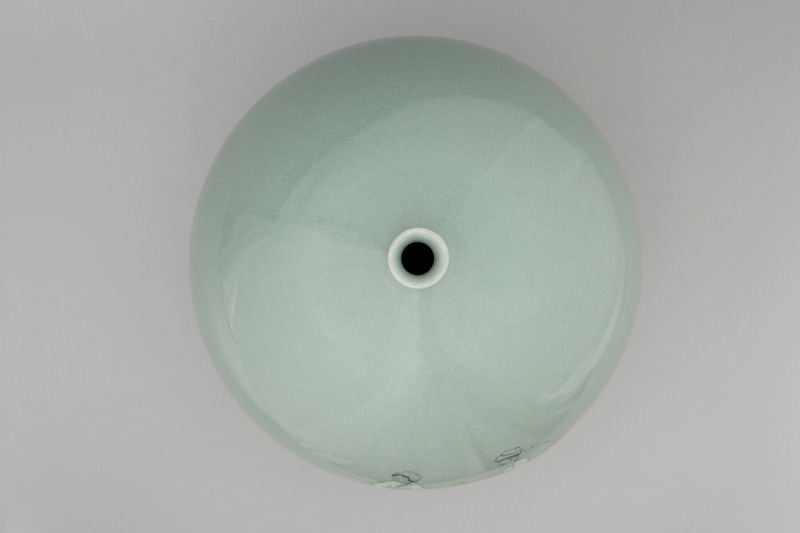Bottle Item Number: 1685/2 from the MOA: University of British Columbia



Description
Spherical vessel known as a cheongja byeong (청자병; celadon bottle) with a small flared neck and raised foot ring. One side of the vessel is decorated with a scene of a man, woman and child; the man is chopping wood; in black and light green on grey-green ground. There is a signature with the artist's pen name and studio in Chinese characters, 海剛 (Haegang) on the base.
History Of Use
All kinds of pottery and porcelain produced during the Goryeo dynasty (고려; 高麗; 918–1392) are called Goryeo dojagi (Goryeo ware; 고려도자기; 高麗陶磁器), and celadon (green-gray glazed ceramic) known as Goryeo cheongja (고려청자; 高麗青磁) was the main kind of ceramics produced during this period in Korea. Celadon originated in China, and Goryeo potters learned the techniques from the celadon traditions of Song dynasty (960–1279) of China. The Buan (부안군) and Gangjin (강진군) regions in Jeolla Province (전라도) became the major production centre by the mid-twentieth century, and Gangjin remains the centre of revivals of Goryeo cheongja and modern celadon production.
Specific Techniques
Glazed; inlaid. Inlay techniques on Goryeo celadons are known as sanggam (상감; 象嵌). Believed to have been produced since the mid-twelfth century in Korea, their origins are not clear. It likely derived from the practice of decorating bronze vessels with silver inlay, and inlaid lacquerware. During the thirteenth and fourteenth centuries, this inlaid technique was widely used in the production of Goryeo celadon.
Item History
- Made by Geun-Hyeong Yu (Maker) in Korea between 1967 and 1993
- Owned by Government of the Republic of Korea before November 20, 1995
- Received from Government of the Republic of Korea (Donor) on November 20, 1995
What
Who
- Culture
- Korean
- Creator
- Geun-Hyeong Yu (Maker)
- Previous Owner
- Government of the Republic of Korea
- Received from
- Government of the Republic of Korea (Donor)
Where
- Holding Institution
- MOA: University of British Columbia
- Made in
- Korea
When
- Creation Date
- between 1967 and 1993
- Ownership Date
- before November 20, 1995
- Acquisition Date
- on November 20, 1995
Other
- Item Classes
- ceramics
- Condition
- excellent
- Accession Number
- 1685/0002